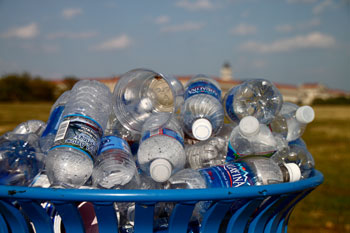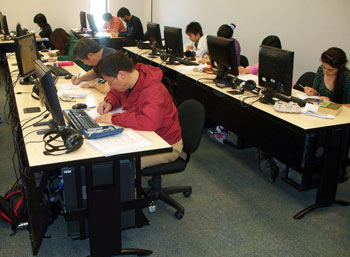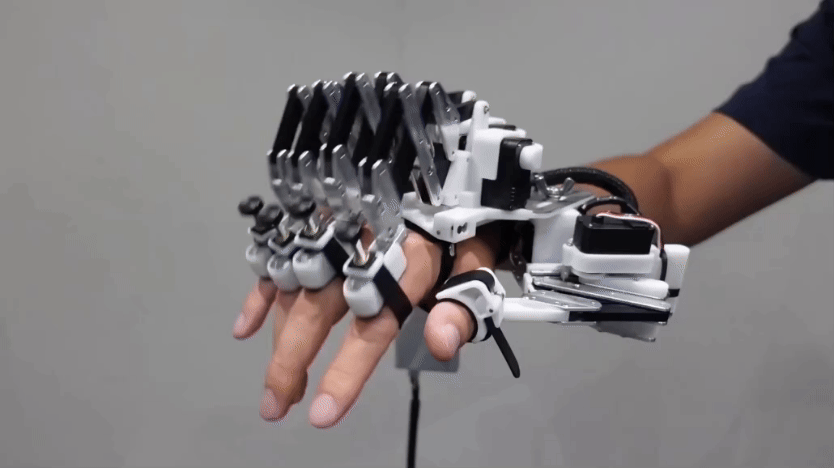Cool Jobs: Getting in your head
Psychologists study behavior and the brain — in everything from monkeys and dogs to people

This common marmoset chews on trees then waits for gooey gum to ooze into the gash before it can eat. Experimental psychologists study how behavior — such as patience — has evolved.
Tim Ellis/Flickr (CC BY-NC 2.0)
Why would a person prefer $100 today instead of more tomorrow? Why can dogs understand a person’s pointing gesture, but chimpanzees cannot? How can we help people make better decisions for themselves and the environment? These are just a handful of questions asked by scientists who work as psychologists.
The word psychologist may bring to mind a picture of a patient spilling his or her troubles to a sympathetic ear. But many psychologists, including one of us (Jeff Stevens), do not work with people who have mental or emotional issues. Some don’t study people at all.
“We carefully investigate behavior and the brain, trying to understand how and why people and other animals do what they do.” Stevens says. “Our experiments may involve animals, such as dogs or chimpanzees. Or we may use what we know about how humans relate to each other to influence the choices people make.” Read on for a peek into the world of experimental psychology.
Getting at the roots of patience
If you have ever cashed in a piggy bank full of hard-earned money, you know how tough it can be to save for the future. But when the reward is big enough — a new smartphone perhaps — it’s easier to wait. There’s a trade-off between the size of the reward and the amount of time we are willing to wait for it.
The same is true for other animals. “This is what I study as a psychologist at University of Nebraska in Lincoln,” notes Jeffrey Stevens. Animals won’t wait for money, of course, but they will wait for other things, such as food.
For years, psychologists studied pigeons and rats to try to understand how long they would wait for food. Both species are commonly used in lab research. And both, scientists find, are impulsive. They are willing to wait only a few seconds for a bigger meal.
But such studies did not provide the full story. That’s because these experiments did not mirror real-life situations that these animals might face, Jeff Stevens points out.
“I decided to take a different approach. I wanted to know what factors might influence whether animals would be impulsive or patient in their natural habitat,” he says. So he worked with two species of monkey, cotton-top tamarins and common marmosets. These squirrel-like monkeys live in the forests of South America. They share a lot in common. Both live in groups within similar types of habitats. And both eat many of the same foods — with one exception: Marmosets eat gum.
Gum is the sticky sap of trees. When a tree is wounded, this thick substance oozes into the opening, protecting the tree from infection. It also is high in sugar, making it an ideal food for animals that can get it — such as marmosets. These monkeys (unlike tamarins) have specialized teeth for tearing into bark. And their digestive system easily handles the gummy diet.
Jeff Stevens wanted to know whether marmosets also had behavioral changes, or adaptations, that made them more suited to their environment. Gum is slow to form. Would the marmosets be willing to wait longer for a meal?

Working with monkeys in the lab, “I gave both marmosets and tamarins a choice,” he explains. They could eat either two food pellets or six. All monkeys opted for the larger amount.
Then he began delaying how long the monkeys had to wait for the six-pellet meal. They could choose the two-pellet meal immediately or wait one second longer and receive the bigger meal. Then the animals had to wait two seconds for the bigger portion. Then three seconds. And so on. Stevens kept delaying how long the monkeys had to wait for the bigger meal until they reached a point at which they were equally likely to wait for six pellets as they were to settle for two right away.
Tamarins reached that point when they had to wait for 8 seconds. Marmosets, however, waited almost twice as long. “As I had suspected,” Jeff Stevens notes, the marmosets were more patient.
He and his team then did a similar study with bonobos and chimpanzees. Chimpanzees hunt food, which requires patience. Bonobos, however, rarely hunt. Both species of that ape regularly eat fruit. The researchers offered the animals either two or six grape halves, again increasing the delay before the animals could have the larger amount. As expected, chimpanzees were more patient. They waited an average of 120 seconds for the bigger group of grapes. Bonobos, however, waited only 74 seconds.
Other researchers began doing similar studies on other primate species. This led Stevens to look at other characteristics that might influence patience. To do so, he used a scientific approach called the comparative method. It compares species that live in different environments or that differ in other ways. By examining how each species deals with a particular problem (such as waiting for food), scientists can see what factors might have caused certain behaviors to evolve.

His Nebraska team examined 13 primate species that had been tested for their patience. “I then observed how those levels of patience related to different traits,” Stevens recalls. These included body size, brain size, typical group size and the size of the home ranges (areas) in which the species lived in the wild. The only trait he could link to patience was a species’ body size.
That makes sense, Stevens now says. Small animals have a faster metabolism. That’s the rate at which their bodies burn energy. So they can’t afford to wait for food. The fact that the animals’ brain size was not linked with how patient they were also is important. “They’re not simply smarter,” Stevens concludes. Instead, their ability to be patient appears to be an adaptation to the world in which they live.
Pointing the way
Animals aren’t only adapted to their physical environments, such as their habitat and climate. Social interactions also can affect behaviors. A good example comes from another researcher. She works with canines.
Dogs have good noses. Still, they often need a little help to find a dropped piece of food. Point in the right direction and they’ll find it straight away. That ability to understand what people are communicating is unusual in the animal kingdom. So unusual that even chimpanzees can’t do it, says Juliane Kaminski. She’s a psychologist at the University of Portsmouth in England.
Kaminski began studying dogs after realizing her trusty companion could do things that the closest of our ape cousins could not. She wondered whether dogs’ social cognition — their ability to process information about social interactions — might have evolved in response to life among people.
For one study, she recruited dog owners in Leipzig, Germany. Researchers brought adult dogs into a room where Kaminski had two cups. Some dogs watched while she put a piece of food under one of the cups. Others couldn’t see where the food went. Kaminski then pointed to one of the cups. Sometimes it was the one with food. Sometimes it wasn’t. Most dogs that had watched her bait the cup went directly to that cup, regardless of her pointing gesture. But dogs that did not already know the location of the food chose the cup she pointed at more often than the other one.

It was possible the dogs had learned the purpose of pointing prior to the experiment through experience with their owners. But Kaminski suspected dogs might be able to understand human communication without that training. To find out, she did a similar experiment using puppies. Some were just six weeks old. All of the puppies still lived with their mothers. They had not spent enough time around people to learn what pointing meant.
In this experiment, a member of Kaminski’s team showed each puppy a piece of food. Then the scientist touched each of two upside-down bowls, placing the food under one. She was careful to make sure the puppy could not see which bowl she put the food under. The experimenter sat between the two bowls and pointed to the one hiding the food. Three out of every four times, the puppy went to the correct bowl.
The fact that such young puppies can follow human gestures suggests that the ability is ingrained in their genes, Kaminski says. Wolves can’t do this, not even ones that were raised by people from pups. That difference may mean that dogs have evolved the ability to understand human communication over the past 15,000 years. That’s how long scientists think dogs have lived with people.
“Dogs’ social cognition seems to have adapted specifically to life with humans,” Kaminski concludes.
Giving people a nudge
Not all psychology research takes place in a lab. Some of it studies real-world situations where scientists hope to encourage positive change.
When psychologist Wesley Schultz was a graduate student in California, recycling was relatively new. The government gave people information to encourage them to recycle. People got facts, for instance, about how much waste could be kept out of landfills if they recycled more. But researchers found that those messages weren’t very effective. So Schultz, then at Claremont Graduate University, decided to try something new.
He measured how much waste each household put at the curb for recycling each week. He collected those data for two months. He then gave individual households information about how much their neighbors recycled, and how this compared to their own recycling. When people saw how they measured up to the people around them, their behavior changed. Most began recycling more.
“It worked quite well,” Schultz says. That’s because people were responding to social norms, he explains. Norms are typical, or “normal,” attitudes and behaviors within a society. Schultz has found that norms have a powerful influence on human behavior.

“We use other people as a guide for our own actions,” he says. And doing so has a strong evolutionary basis. Throughout history, the most successful people lived in groups and worked together, Schultz explains. That meant people constantly compared their behavior to what others did. They wanted to make sure they fit in with the crowd.
In Schultz’s first study, as people learned that their neighborhood’s norm was to recycle, more households began to join in. Simply providing information about the benefits of recycling didn’t change behavior nearly as much as the norm-based nudge that Schultz provided.
Schultz is now at California State University in San Marcos. He has continued to study how norms can guide behavior. In one study, he and his team tested the effect of signs and perceived norms to reduce energy use.
In a campus computer lab, they attached small signs asking users to shut off the computers when they were done using them. Some computers had signs and were turned off. Others had signs but were left on. Still others had no signs. Some of this group of computers were left on while others were turned off.
The researchers quietly observed students as they used the lab and then left. They recorded the state of the computer as each student arrived. Then they recorded whether students turned off the computer or monitor as they left.

When there was no sign and the computers and the monitors were left on, only three percent of students turned off the power to the devices they had used. When students saw signs asking them to turn off computers and monitors, 11 percent did so. And when signs were paired with a computer that was already off, nearly half of the students shut down the unit before they left. Fifteen percent of students who found a computer turned off, even with no sign, turned it off when they were done. The researchers chalked that up to the students’ perceiving a norm that people turned off computers when they were finished working.
“Most people want to use less [energy] and be part of the solution,” Schultz says. But they don’t want to change their behavior if no one else does. The right kinds of nudges, he now believes, can really motivate change.
Schultz, like Stevens and Kaminski, is driven to understand the origins of behavior. And he is working hard to put what he learns to good use, helping people understand why individuals do what they do — and how humans, at least, might do it better.
Alison P. Stevens and Jeffrey R. Stevens are scientists married to each other. Alison Stevens also is a science journalist.
This is one in a series on careers in science, technology, engineering and mathematics made possible with generous support from Alcoa Foundation.
Power Words
(for more about Power Words, click here)
adaptation A process by which an organism or species becomes better suited to its environment. When a community of organisms does this over time, scientists refer to the change as evolution.
ape A group of rather large “Old World” primates that lack a tail. They include the gorilla, chimpanzees, bonobos, orangutans and gibbons.
behavior The way a person or other organism acts towards others, or conducts itself.
climate The weather conditions prevailing in an area in general or over a long period.
cognition The mental processes of thought, remembering, learning information and interpreting those data that the senses send to the brain. Activities such as thinking, learning, remembering and solving puzzles are known as cognitive activities.
common marmoset A small brown, gray and yellow monkey that lives in the rainforests of Brazil. They have specialized teeth and digestive organs that allow them to eat gum from trees.
comparative method Studying a group of related species in order to understand the evolutionary roots of behavior and how those behaviors are adapted to the species’ environment.
correlation A mutual relationship or connection between two variables. When there is a positive correlation, an increase in one variable is associated with an increase in the other. (For instance, scientists might correlate an increase in time spent watching TV with an increase in risk of obesity.) Where there is an inverse correlation, an increase in one value is associated with a decrease in the other. (Scientists might correlate an increase in TV watching with a decrease in time spent exercising each week.) A correlation between two variables does not necessarily mean one is causing theother.
cotton-top tamarin Small gray and white monkeys found in the rainforests of Colombia. They primarily eat plants and insects.
domestication A process of producing a tame version of an animal from a wild one, which can take thousands of years.
drought An extended period of abnormally low rainfall; a shortage of water resulting from this.
evolution A process by which species undergo changes over time, usually through genetic variation and natural selection. These changes usually result in a new type of organism better suited for its environment than the earlier type. The newer type is not necessarily more “advanced,” just better adapted to the conditions in which it developed.
experimental psychology A field of psychology in which scientists propose hypotheses and design experiments to test them. Scientists who work in this field are called experimental psychologists.
graduate student Someone working toward an advanced degree by taking classes and performing research. This work is done after the student has already graduated from college (usually with a four-year degree).
gum (in botany) A thick, sticky substance exuded by plants when they have been wounded. Animals known as gummivores specialize in eating gum.
habitat The area or natural environment in which an animal or plant normally lives, such as a desert, coral reef or freshwater lake. A habitat can be home to thousands of different species.
impulsive Quick to act, not willing to wait.
metabolism The set of life-sustaining chemical reactions that take place inside cells. These reactions enable organisms to grow, reproduce, move and otherwise respond to their environments.
norms The attitudes, behaviors or achievements that are considered normal or conventional within a society (or segment of society — such as teens) at the present time.
primate The order of mammals that includes humans, apes, monkeys and related animals (such as tarsiers, the Daubentonia and other lemurs).
psychology The study of the human mind, especially in relation to actions and behavior. Scientists and mental-health professionals who work in this field are known as psychologists.
range The full extent or distribution of something. For instance, a plant or animal’s range is the area over which it naturally exists. (in math or for measurements) The extent to which variation in values is possible. Also, the distance within which something can be reached or perceived.
recycle To find new uses for something — or parts of something — that might otherwise be discarded, or treated as waste.
social cognition How a person (or other animal) processes information dealing with social interactions.
Word Find (click here to enlarge for printing)








